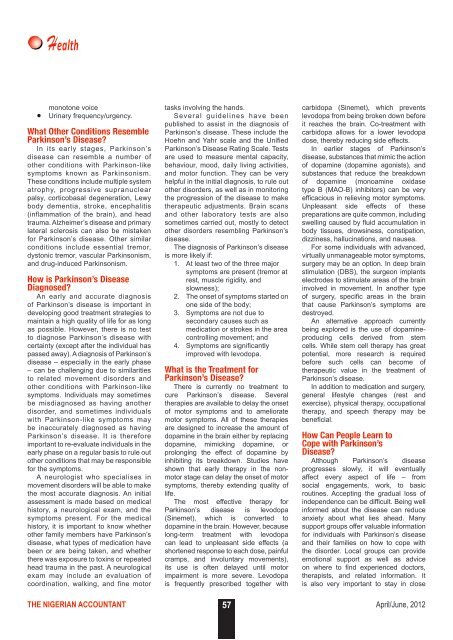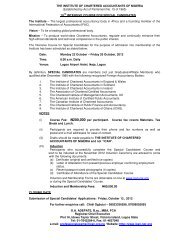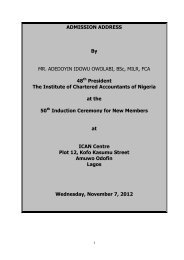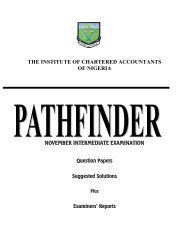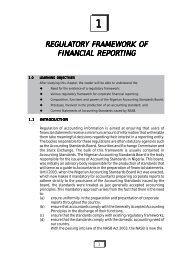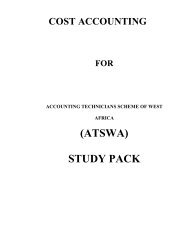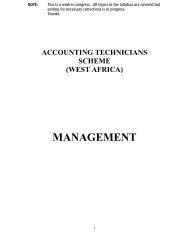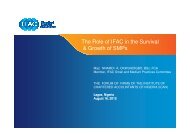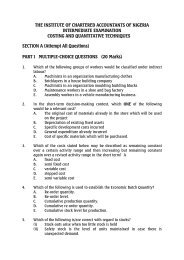The Nigerian Accountant 2012 - The Institute of Chartered ...
The Nigerian Accountant 2012 - The Institute of Chartered ...
The Nigerian Accountant 2012 - The Institute of Chartered ...
Create successful ePaper yourself
Turn your PDF publications into a flip-book with our unique Google optimized e-Paper software.
Health<br />
monotone voice<br />
• Urinary frequency/urgency.<br />
What Other Conditions Resemble<br />
Parkinson’s Disease?<br />
In its early stages, Parkinson’s<br />
disease can resemble a number <strong>of</strong><br />
other conditions with Parkinson-like<br />
symptoms known as Parkinsonism.<br />
<strong>The</strong>se conditions include multiple system<br />
atrophy, progressive supranuclear<br />
palsy, corticobasal degeneration, Lewy<br />
body dementia, stroke, encephalitis<br />
(inflammation <strong>of</strong> the brain), and head<br />
trauma. Alzheimer’s disease and primary<br />
lateral sclerosis can also be mistaken<br />
for Parkinson’s disease. Other similar<br />
conditions include essential tremor,<br />
dystonic tremor, vascular Parkinsonism,<br />
and drug-induced Parkinsonism.<br />
How is Parkinson’s Disease<br />
Diagnosed?<br />
An early and accurate diagnosis<br />
<strong>of</strong> Parkinson’s disease is important in<br />
developing good treatment strategies to<br />
maintain a high quality <strong>of</strong> life for as long<br />
as possible. However, there is no test<br />
to diagnose Parkinson’s disease with<br />
certainty (except after the individual has<br />
passed away). A diagnosis <strong>of</strong> Parkinson’s<br />
disease – especially in the early phase<br />
– can be challenging due to similarities<br />
to related movement disorders and<br />
other conditions with Parkinson-like<br />
symptoms. Individuals may sometimes<br />
be misdiagnosed as having another<br />
disorder, and sometimes individuals<br />
with Parkinson-like symptoms may<br />
be inaccurately diagnosed as having<br />
Parkinson’s disease. It is therefore<br />
important to re-evaluate individuals in the<br />
early phase on a regular basis to rule out<br />
other conditions that may be responsible<br />
for the symptoms.<br />
A neurologist who specialises in<br />
movement disorders will be able to make<br />
the most accurate diagnosis. An initial<br />
assessment is made based on medical<br />
history, a neurological exam, and the<br />
symptoms present. For the medical<br />
history, it is important to know whether<br />
other family members have Parkinson’s<br />
disease, what types <strong>of</strong> medication have<br />
been or are being taken, and whether<br />
there was exposure to toxins or repeated<br />
head trauma in the past. A neurological<br />
exam may include an evaluation <strong>of</strong><br />
coordination, walking, and fine motor<br />
tasks involving the hands.<br />
Several guidelines have been<br />
published to assist in the diagnosis <strong>of</strong><br />
Parkinson’s disease. <strong>The</strong>se include the<br />
Hoehn and Yahr scale and the Unified<br />
Parkinson’s Disease Rating Scale. Tests<br />
are used to measure mental capacity,<br />
behaviour, mood, daily living activities,<br />
and motor function. <strong>The</strong>y can be very<br />
helpful in the initial diagnosis, to rule out<br />
other disorders, as well as in monitoring<br />
the progression <strong>of</strong> the disease to make<br />
therapeutic adjustments. Brain scans<br />
and other laboratory tests are also<br />
sometimes carried out, mostly to detect<br />
other disorders resembling Parkinson’s<br />
disease.<br />
<strong>The</strong> diagnosis <strong>of</strong> Parkinson’s disease<br />
is more likely if:<br />
1. At least two <strong>of</strong> the three major<br />
symptoms are present (tremor at<br />
rest, muscle rigidity, and<br />
slowness);<br />
2. <strong>The</strong> onset <strong>of</strong> symptoms started on<br />
one side <strong>of</strong> the body;<br />
3. Symptoms are not due to<br />
secondary causes such as<br />
medication or strokes in the area<br />
controlling movement; and<br />
4. Symptoms are significantly<br />
improved with levodopa.<br />
What is the Treatment for<br />
Parkinson’s Disease?<br />
<strong>The</strong>re is currently no treatment to<br />
cure Parkinson’s disease. Several<br />
therapies are available to delay the onset<br />
<strong>of</strong> motor symptoms and to ameliorate<br />
motor symptoms. All <strong>of</strong> these therapies<br />
are designed to increase the amount <strong>of</strong><br />
dopamine in the brain either by replacing<br />
dopamine, mimicking dopamine, or<br />
prolonging the effect <strong>of</strong> dopamine by<br />
inhibiting its breakdown. Studies have<br />
shown that early therapy in the nonmotor<br />
stage can delay the onset <strong>of</strong> motor<br />
symptoms, thereby extending quality <strong>of</strong><br />
life.<br />
<strong>The</strong> most effective therapy for<br />
Parkinson’s disease is levodopa<br />
(Sinemet), which is converted to<br />
dopamine in the brain. However, because<br />
long-term treatment with levodopa<br />
can lead to unpleasant side effects (a<br />
shortened response to each dose, painful<br />
cramps, and involuntary movements),<br />
its use is <strong>of</strong>ten delayed until motor<br />
impairment is more severe. Levodopa<br />
is frequently prescribed together with<br />
carbidopa (Sinemet), which prevents<br />
levodopa from being broken down before<br />
it reaches the brain. Co-treatment with<br />
carbidopa allows for a lower levodopa<br />
dose, thereby reducing side effects.<br />
In earlier stages <strong>of</strong> Parkinson’s<br />
disease, substances that mimic the action<br />
<strong>of</strong> dopamine (dopamine agonists), and<br />
substances that reduce the breakdown<br />
<strong>of</strong> dopamine (monoamine oxidase<br />
type B (MAO-B) inhibitors) can be very<br />
efficacious in relieving motor symptoms.<br />
Unpleasant side effects <strong>of</strong> these<br />
preparations are quite common, including<br />
swelling caused by fluid accumulation in<br />
body tissues, drowsiness, constipation,<br />
dizziness, hallucinations, and nausea.<br />
For some individuals with advanced,<br />
virtually unmanageable motor symptoms,<br />
surgery may be an option. In deep brain<br />
stimulation (DBS), the surgeon implants<br />
electrodes to stimulate areas <strong>of</strong> the brain<br />
involved in movement. In another type<br />
<strong>of</strong> surgery, specific areas in the brain<br />
that cause Parkinson’s symptoms are<br />
destroyed.<br />
An alternative approach currently<br />
being explored is the use <strong>of</strong> dopamineproducing<br />
cells derived from stem<br />
cells. While stem cell therapy has great<br />
potential, more research is required<br />
before such cells can become <strong>of</strong><br />
therapeutic value in the treatment <strong>of</strong><br />
Parkinson’s disease.<br />
In addition to medication and surgery,<br />
general lifestyle changes (rest and<br />
exercise), physical therapy, occupational<br />
therapy, and speech therapy may be<br />
beneficial.<br />
How Can People Learn to<br />
Cope with Parkinson’s<br />
Disease?<br />
Although Parkinson’s disease<br />
progresses slowly, it will eventually<br />
affect every aspect <strong>of</strong> life – from<br />
social engagements, work, to basic<br />
routines. Accepting the gradual loss <strong>of</strong><br />
independence can be difficult. Being well<br />
informed about the disease can reduce<br />
anxiety about what lies ahead. Many<br />
support groups <strong>of</strong>fer valuable information<br />
for individuals with Parkinson’s disease<br />
and their families on how to cope with<br />
the disorder. Local groups can provide<br />
emotional support as well as advice<br />
on where to find experienced doctors,<br />
therapists, and related information. It<br />
is also very important to stay in close<br />
THE NIGERIAN ACCOUNTANT 57<br />
April/June, <strong>2012</strong>


